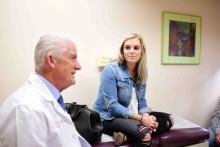451-460 of 3308 Results Found
Condition
Ewing Sarcoma in Children What is Ewing sarcoma in children? Ewing sarcoma is a rare type of cancer. It can affect a person of any age but it’s most common between ages 10 and 20. It often grows in bone, but it can also grow in soft tissue that’s connected to the bone. This may
Article
Going High Tech to Treat Epilepsy
Barrow Neurological Institute at Phoenix Children’s Epilepsy Program is on the cutting edge of diagnosing and treating pediatric epilepsy.


Condition
Congenital Laryngeal Stridor in Babies What is congenital laryngeal stridor? Congenital laryngeal stridor is a noisy or high-pitched sound with breathing. It is from an abnormally formed voice box (larynx). It's present at birth (congenital). What causes congenital laryngeal

General Contact Form
… General Contact Form Home Contact Form Phoenix Children’s Contact Form is currently not working due to a technical issue. We apologize for the inconvenience. …
CME Session
VWGR - From Reels to Real Learning: Growing as an Educator by Creating Content - Paul Tran, MD
… VWGR - From Reels to Real Learning: Growing as an Educator by Creating Content … - 07:30 Session Objectives: Understand why educational best practices are important to educators and clinicians … three elements of effective education Explore practical ways for busy clinicians to improve patient and learner …
CME Session
PCH - Hemophagocytic Lymphohistiocytosis "HLH: 101 to 2025" - Ashish Kumar, MD, PhD (Cincinnati Children's - Cincinnati, OH)
At the end of this presentation, participants should be able to: Understand the pathophysiology of and diagnostic challenges in HLH Recognize the limitations of the HLH-2004 diagnostic criteria and HScore Identify newer diagnostic assays and their applications

Condition
Contact Dermatitis What is contact dermatitis? Contact dermatitis is a reaction that happens after your skin comes in direct contact with certain substances. The substances may be: Irritants. These cause direct skin irritation and inflammation. They are the most common cause of
